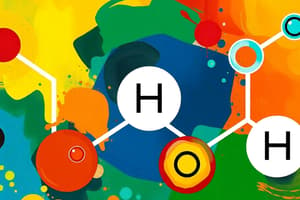Podcast
Questions and Answers
Which functional group is characterized by a -C=O bond located in the middle of a carbon chain?
Which functional group is characterized by a -C=O bond located in the middle of a carbon chain?
- Aldehydes
- Alcohols
- Carboxylic Acids
- Ketones (correct)
Which mechanism is favored for nucleophilic substitution of primary alkyl halides?
Which mechanism is favored for nucleophilic substitution of primary alkyl halides?
- SN1 Mechanism
- E1 Mechanism
- E2 Mechanism
- SN2 Mechanism (correct)
What type of isomerism involves non-superimposable mirror images?
What type of isomerism involves non-superimposable mirror images?
- Structural Isomers
- Geometric Isomers
- Stereoisomers
- Enantiomers (correct)
In which mechanism does the removal of hydrogen and halide occur simultaneously?
In which mechanism does the removal of hydrogen and halide occur simultaneously?
What is the functional group of amines known for?
What is the functional group of amines known for?
Which type of structural isomerism involves different connectivity of atoms?
Which type of structural isomerism involves different connectivity of atoms?
What is the primary application of alkyl halides in organic synthesis?
What is the primary application of alkyl halides in organic synthesis?
What trend is observed regarding the reactivity of alkyl halides?
What trend is observed regarding the reactivity of alkyl halides?
Flashcards are hidden until you start studying
Study Notes
Organic Chemistry
-
Definition: Study of carbon-containing compounds and their properties, structures, and reactions.
-
Key Functional Groups:
- Alcohols: -OH group; polar; soluble in water.
- Aldehydes: -CHO group; carbonyl at end of carbon chain.
- Ketones: -C=O group; carbonyl in the middle of carbon chain.
- Carboxylic Acids: -COOH group; acidic properties.
- Esters: Derived from acids; -COOR group.
- Amines: Contain nitrogen; basic properties.
-
Isomerism:
- Structural Isomers: Different connectivity of atoms.
- Stereoisomers: Same connectivity; different spatial arrangement.
- Geometric Isomers: Cis-trans variations.
- Enantiomers: Non-superimposable mirror images.
-
Nomenclature: Systematic naming based on IUPAC rules; identifies longest carbon chain, functional groups, and substituents.
Conversions of Alkyl Halides
-
Definition: Alkyl halides are organic compounds containing a halogen atom bonded to an alkyl group.
-
Conversion Reactions:
-
Nucleophilic Substitution:
- SN1 Mechanism: Two-step process; formation of carbocation intermediate; favored by tertiary alkyl halides.
- SN2 Mechanism: One-step process; involves backside attack; favored by primary alkyl halides.
-
Elimination Reactions:
- E1 Mechanism: Two-step process; formation of a carbocation; produces alkenes; favored by tertiary alkyl halides.
- E2 Mechanism: One-step process; simultaneous removal of hydrogen and halide; favored by bulky bases.
-
-
Reduction Reactions:
- Alkyl halides can be reduced to alkanes using zinc or lithium aluminum hydride (LiAlH4).
-
Applications:
- Synthesis of alcohols, alkenes, and other functional groups.
- Important in pharmaceuticals, agrochemicals, and polymer industries.
-
Reactivity Trends:
- Reactivity decreases with increasing carbon chain length and steric hindrance.
- Primary alkyl halides are more reactive in SN2, while tertiary are more reactive in SN1.
Organic Chemistry
- Definition: Examines carbon-based compounds, their structures, properties, and reactions.
- Key Functional Groups:
- Alcohols: Characterized by -OH group, exhibit polarity, and are water-soluble.
- Aldehydes: Contain -CHO group with a carbonyl positioned at the end of the chain.
- Ketones: Feature -C=O group with carbonyl located within the chain.
- Carboxylic Acids: Identified by -COOH group, exhibiting acidic properties.
- Esters: Formed from acids with the -COOR group.
- Amines: Contain nitrogen, displaying basic properties.
- Isomerism:
- Structural Isomers: Differ in atom connectivity.
- Stereoisomers: Inform same connectivity but differ in spatial arrangement.
- Geometric Isomers: Include cis-trans forms.
- Enantiomers: Non-superimposable mirror images, creating chirality.
- Nomenclature: Follows IUPAC guidelines; includes longest carbon chain, functional groups, and substituents.
Conversions of Alkyl Halides
- Definition: Organic compounds with a halogen atom bonded to an alkyl group, known as alkyl halides.
- Conversion Reactions:
- Nucleophilic Substitution:
- SN1 Mechanism: A two-step process involving carbocation formation; favored by tertiary alkyl halides.
- SN2 Mechanism: A one-step process that requires backside attack; favored by primary alkyl halides.
- Elimination Reactions:
- E1 Mechanism: Similar to SN1, it's a two-step process resulting in alkenes; favored by tertiary alkyl halides.
- E2 Mechanism: A one-step process where hydrogen and halide are removed simultaneously; favored by bulky bases.
- Reduction Reactions: Alkyl halides can be reduced to alkanes using zinc or lithium aluminum hydride (LiAlH4).
- Nucleophilic Substitution:
- Applications: Vital for synthesizing alcohols, alkenes, and other functional groups; influential in pharmaceuticals, agrochemicals, and polymer development.
- Reactivity Trends:
- Reactivity diminishes with longer carbon chains and increased steric hindrance.
- Primary alkyl halides more reactive in SN2 reactions; tertiary halides more reactive in SN1.
Studying That Suits You
Use AI to generate personalized quizzes and flashcards to suit your learning preferences.




